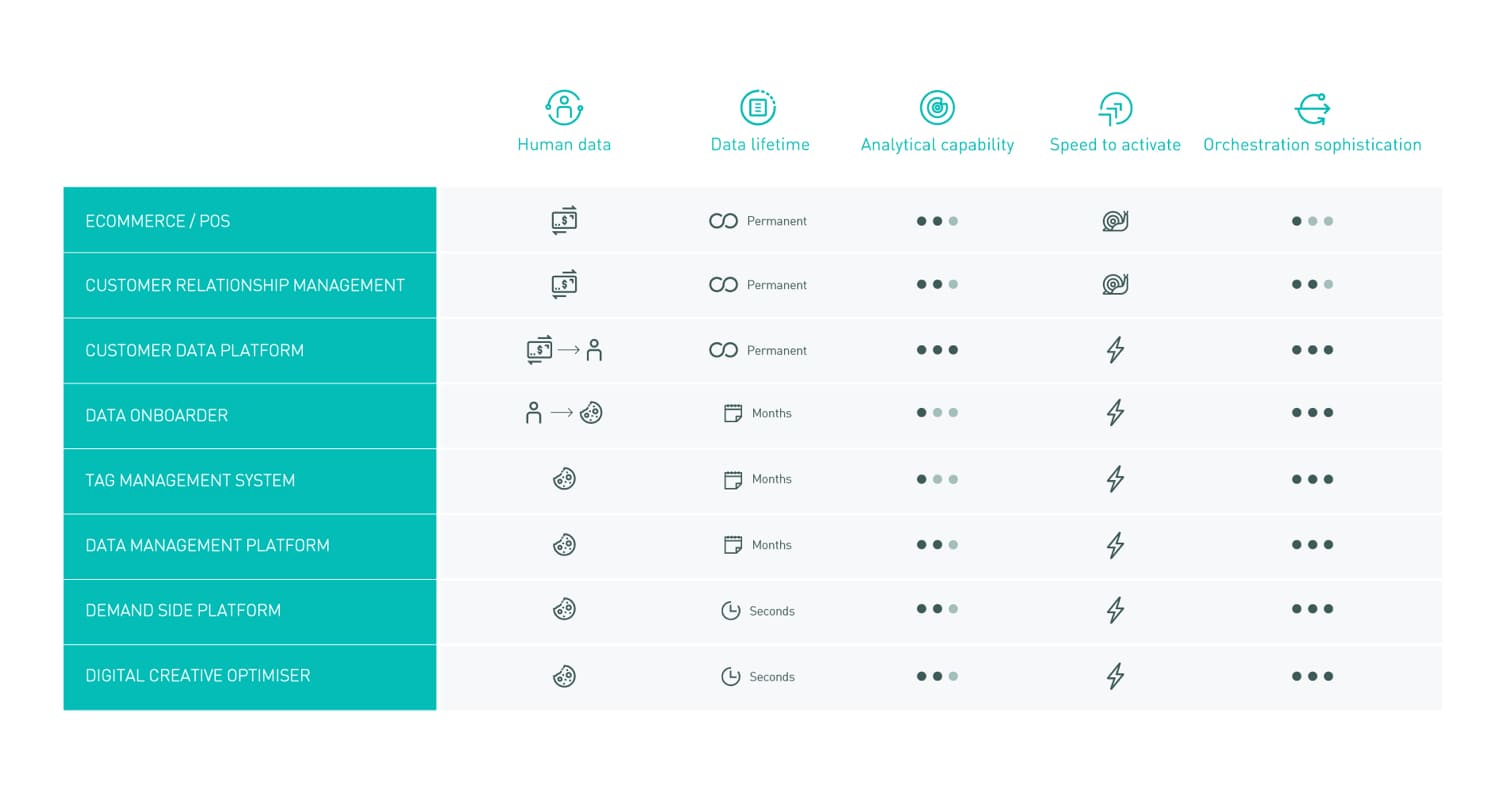August 23, 2018
The complete martech guide to CRM, CDP, DMP and more
Martech has the potential to enable hyper-effective personalization on multiple channels and automate repetitive tasks.
But there are thousands of new niche technologies that solve every problem in a different way — so how do you build the best Martech stack for your business?
In this seven-part series and downloadable guide to marketing automation, we break down the role and limitations of the 7 key types of platforms in the Martech landscape today and benchmark each technology against key features.
- Part 1: Customer Relationship Management (CRM)
- Part 2: Customer Data Platform (CDP)
- Part 3: Data Onboarder (DO)
- Part 4: Tag Management System (TMS)
- Part 5: Data Management Platform (DMP)
- Part 6: Demand Side Platform (DSP)
- Part 7: Dynamic Creative Optimizer (DCO)
Let’s Start At the Very Beginning: What is Martech?
Martech enables marketing automation. The term refers to tools that help deliver effective personalization on multiple channels and automate repetitive tasks.
So, what are the roles and limitations of each technology in delivering bottom-line ROI?
Part 1: Customer Relationship Management (CRM)
A CRM helps you oversee and manage the sales and service history with every known customer. Originating from one-to-one sales workflows, a CRM can provide cross-channel contact history and servicing tools.
Part 2: Customer Data Platform (CDP)
A CDP is a persistent, unified (known and unknown) customer database from both online and offline sources. Easily accessible by all Martech solutions, a CDP comes with user-friendly business analytics and activation tools.
Part 3: Data Onboarder (DO)
A DO is an expert in connecting email addresses (PII – known customers) to cookies (unknown prospects). This tool enables marketers to create addressable segments to target or suppress across the digital advertising ecosystem.
Part 4: Tag Management System (TMS)
A TMS manages the integration of tags from third-party software into owned digital properties.
Part 5: Data Management Platform (DMP)
A DMP provides a centralized dataset that aggregates cookie browsing behavior (unknown prospects) to create large, de-identified audiences for ad targeting across digital channels.
Part 6: Demand Side Platform (DSP)
A DSP allows for digital advertising to be bought in a completely automated way, enabling multiple advertisers to bid for an audience and serve an ad — all within milliseconds.
Part 7: Dynamic Creative Optimiser (DCO)
A DCO is a system that analyses multiple data points on each visitor and selects the ideal creative to serve from a library of dynamic or pre-created messages — all in real-time.
The 5 Features of the MarTech Landscape That Matter
The game has changed.
Customer data is now created and utilized by more and more technology. However, each type of software is usually very good at some aspect of the 5 critical factors.
Note: Very good is a vital qualification, as technology generally can do many things poorly and only a few very well. It’s challenging, but essential for you to understand the nuance with each vendor to feel confident about where you stand.
Here are the 5 factors that truly matter:
- Human data: Identifying devices (via cookies) or people (via Personally Identifiable Information – PII).
- Data lifetime: Storing information temporarily (microseconds to months) or permanently (literally forever).
- Analytical capability: Software enables varying levels of analytics, from simple static to multidimensional.
- Speed to activate: Data is real-time (microseconds to seconds) or delayed (days to weeks)
- Orchestration sophistication: Customers can be directly engaged manually (with a human) or in real-time activations.
So How Does Each Technology Stack Up Against These 5 Factors?

What’s Next?
As always, start with the customer experience you’re trying to deliver. Are you looking to win new customers? Are they known or unknown customers? Are you after solutions for prospecting, or retention, or perhaps both?
Whatever your purpose is, keep it in mind throughout your solution evaluations. No two businesses are the same, so flexible, tailored solutions are key.
Big data in retail takes lots of manual work to analyze, is not necessarily valuable and generally isn’t actionable. Brands who take a strategic, outcome- and customer-focused approach to their data are the ones who realize significant value.
The key to finding the right technology solutions for your organization is to put the customer first, not the tech.
Brands need to look from the outside in, at the customer need they’re trying to solve, and the value they need to add in order to be the best at what they do. Then find the right tools to help you achieve that.
Download the Full Martech Report
Looking for more detail?
Our comprehensive guide to marketing automation and the Martech landscape answers all of your burning questions about the technology stack that your business needs.
If you’re still not sure, reach out and together we can figure out what solution will work best for you.
Interested in learning more about how Lexer can help you improve customer engagement and maximize results? Book a demo with one of our retail experts today.
